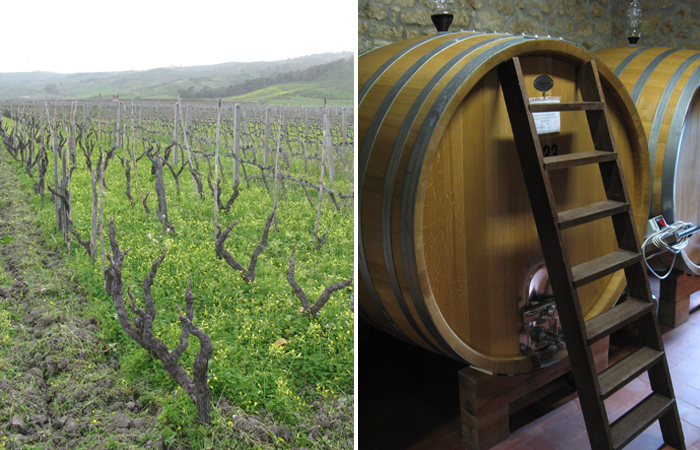Italian Vintage 2013 reports from the Marche, Calabria, Tuscany and Liguria
Author: David Berry Green

Left: Gaglioppo vines at one of Calabria’s star producers, Sergio Arcuri.
Right: Scopetone wines are traditionally made using stainless-steel and 33hl Pauscha Austrian oak botte
First up, Aldo Cifola, winemaker/owner at the La Monacesca estate, recounts how his Verdicchio di Matelica fared: “Summer 2013 was complicated due to the repetitive rain showers in June and July, let alone the unprecedented eight days of rain during the harvest itself! As a result Aldo lost 20 per cent of his Verdicchio (di Matelica), in what was already a low-cropping vintage. Nonetheless they succeeded in harvesting a significant quantity of very good Verdicchio, at acceptable sugar and acidity levels. So a low quantity of high quality fruit.”
It seems the South (of Italy) enjoyed a better season/October than further north, if Calabrian Sergio Arcuri’s report is anything to go by: “Ottima annata! It’s been a long harvest on account of the slow maturation of the (Gaglioppo) fruit, taking place at the right time and finishing on 19th October. Ten per cent more fruit than in 2012, even given the lack of rain, but the summer temperature was not very hot. No fermentation issues, a risk given their decision to ferment spontaneously (using wild yeasts).”
New to Berrys’ range this year are the suave Scopetone wines of Montalcino, made by Loredana Tanganelli and her husband Antonio Brandi, from vineyards just below the historic town centre itself: “2013 wasn’t easy but very interesting, cumulating in high quality and quantity (Sangiovese Grosso) fruit. The weather and (slow) ripening period echoed that of 20/30 years ago, i.e. optimal conditions for ripening the Sangiovese. Spring and early summer were wet, accompanied by hail, which though filling up water reserves, also brought on peronospera, requiring much vineyard work. Great heat arrived during the second half of July, and August, but not excessively as felt in previous years, while cool nights and hot days ensured the build up of complex aromas and fruit tannins.
This continued into September, which was fine and dry, indicating a (later than recent years) harvest period between end Sept and mid October. Harvesting conditions were compromised by frequent and heavy rain showers, threatening rot but those that harvested before the middle of October (as they did!) brought home fruit, balanced in sugar, acidity, freshness and colour. Quantity harvested was about five per cent on previous years due to greater manual selection in the vineyard, ensuring high quality.”
Finally, another new face is Mirco Mastroianni, owner/winemaker on the Ligurian Riviera at the Pigato-producing Cascina Feipu dei Massaretti, based in Albenga, overlooking the Mediterranean: “As regards my region, 2013 was characterised by rain and low temperatures until the beginning of the summer. This resulted in lower sugar and hence alcohol levels of between 1- 0.5 degrees less (which is not a bad thing). That said, the good oscillation of temperatures between day and night during August and during the first 15 days of Sept, has had – in my view and as regards my wines – a positive influence on the (Pigato) aromas.”
More Italian 2013 harvest news to follow from Tenuta di Valgiano (Tuscany), Castello di Luzzano (Emilia-Romagna), Massotina (Veneto), L’Astore Masseria (Puglia)…


